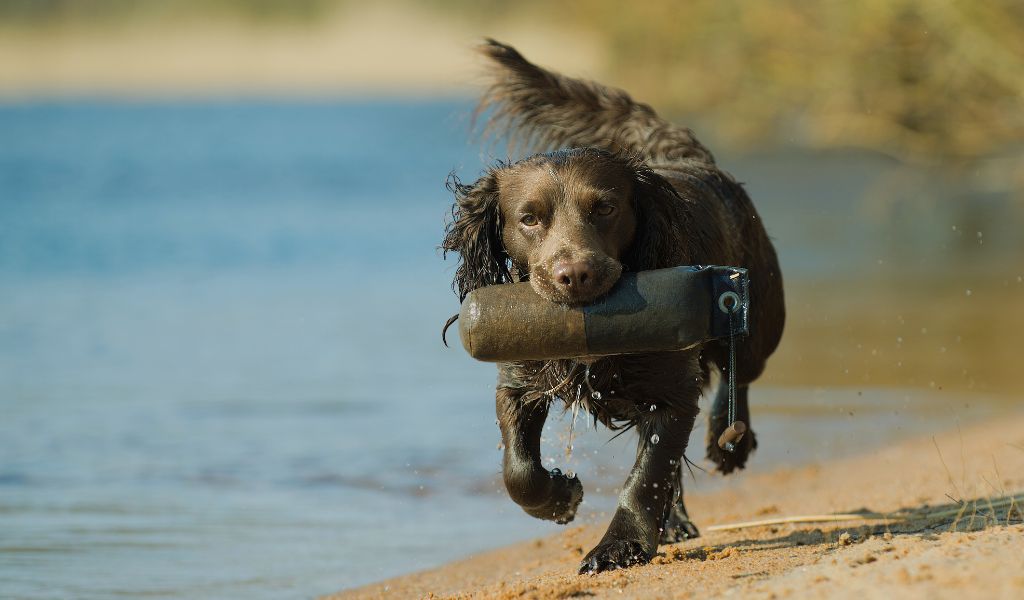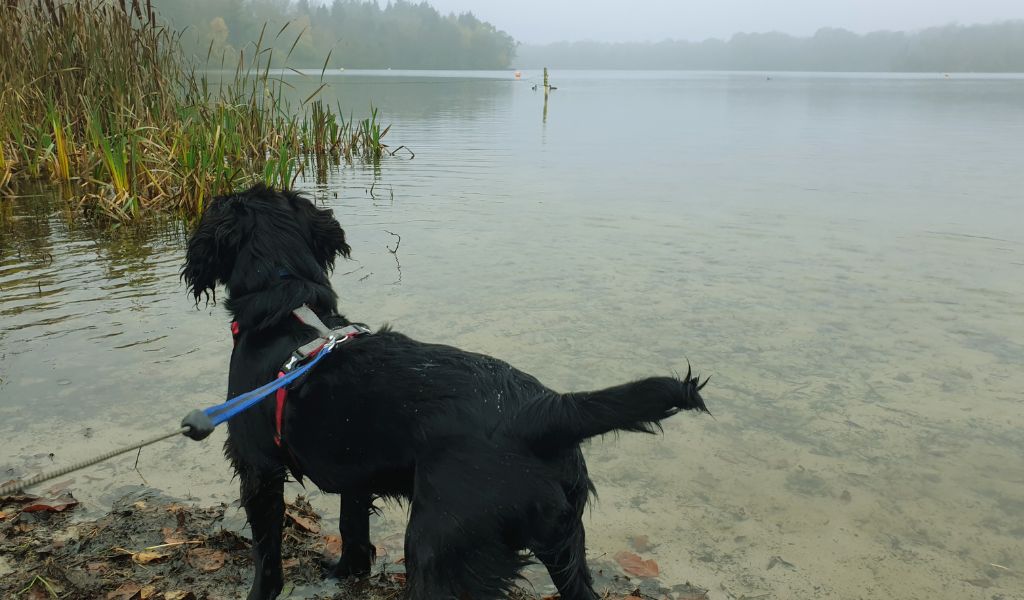Tail docking, the practice of surgically removing a portion of a dog’s tail, has been a controversial topic for many years.
One breed commonly associated with this practice is the Cocker spaniel. The reason behind tail docking in Cocker spaniels varies and has evolved over time.
Historically, tail docking was seen as a way to prevent injury to working dogs, particularly those used for hunting and retrieving game. The belief was that a shorter tail reduced the risk of injury while navigating through dense brush and undergrowth.

Additionally, in some countries, tail docking was believed to prevent specific health issues such as “happy tail syndrome,” in which the tail suffers repeated trauma and fails to heal properly.
However, with changing attitudes towards animal welfare, the practice of tail docking has come under scrutiny.
Many animal welfare organizations and veterinary professionals now argue that tail docking is unnecessary and unethical, causing unnecessary pain and trauma to the dog. As a result, tail docking is now banned or heavily regulated in many countries.
History and tradition of tail docking in Cocker spaniels
The history and tradition of tail docking in Cocker spaniels can be traced back to the breed’s origins in the United Kingdom.
Docking reduced the potential for injury to a working Cocker spaniel’s tail while hunting in dense cover and forested areas.
The tradition of tail docking was also thought to give the spaniels a more streamlined appearance, making them more efficient hunters.

Anatomy and physiology of Cocker spaniels’ tails
Cocker spaniels are known for their distinctive tails, which are often docked to a specific length according to breed standards.
The anatomy of their tails consists of a series of vertebrae, muscles, and nerves, similar to the structure in other dog breeds.
The tail serves various functions, such as communication, balance, and even helping with swimming.
In terms of physiology, the tail is an extension of the dog’s spine, allowing for flexibility and mobility. It also contains muscles that control its movement, allowing for wagging and other forms of expression.
However, docking the tail can have both physical and psychological effects on the dog, as it eliminates an important means of communication and expression.
Therefore, it is important to consider the implications of tail docking in Cocker spaniels and to prioritise the well-being of the dog before going ahead.
The controversy surrounding tail docking
Proponents of tail docking in Cocker spaniels argue that it is necessary to prevent injury and infection, especially for dogs that are often used for hunting or working in the field.
There are also those from a Cocker spaniel show background who believe that it is a traditional practice that is important for maintaining breed standards.
However, opponents of tail docking argue that it is a painful and unnecessary procedure that can cause long-term physical and psychological harm to the dog. They also point out that there is no scientific evidence to support the idea that tail docking prevents injury or infection.
Many countries have banned the practice of tail docking, and it is becoming increasingly scrutinized by animal welfare organizations and veterinarians.
It is a complex issue with strong opinions on both sides, but ultimately the welfare and well-being of the animals should be the top priority.

Legal and ethical considerations of tail docking
From a legal and ethical standpoint, tail docking is a controversial issue. In some countries and states, tail docking is strictly regulated and is only allowed for certain working or hunting dogs.
Other areas have completely banned the practice, citing concerns about animal cruelty and unnecessary pain.
Ethically, many argue that tail docking is a cosmetic procedure that serves no medical benefit to the dog and causes unnecessary pain and distress.
On the other hand, some breeders and owners believe that tail docking is necessary for maintaining certain breed standards and preventing injuries in certain working dogs.
Overall, the legal and ethical considerations of tail docking vary widely depending on the location and the individual beliefs of stakeholders, making it a complex and contentious issue in the world of animal welfare.
Health risks and complications associated with tail docking
One of the most significant risks is the development of chronic pain in the tail region, as the nerves and tissues in the tail may be damaged during the docking process.
In addition, dogs may also experience complications such as infection, excessive bleeding, and improper healing of the wound, all of which can result in further pain and discomfort for the animal.
Furthermore, the altered tail anatomy can lead to issues with balance and communication, as the tail plays a crucial role in signaling a dog’s emotions and intentions to other animals.

Breed standards and tail docking practices
Breed standards are guidelines set by various breed associations to maintain the ideal characteristics and traits of a specific breed.
These standards often include physical attributes such as size, coat colour, and shape of the head and ears.
In some breeds, tail docking is a standard practice and is done to achieve the desired look outlined in the breed standards.
In several countries, tail docking is considered illegal unless it is performed for medical reasons.
It is important for dog owners and breeders to be aware of the breed standards and regulations regarding tail docking in order to ensure the health and well-being of their dogs while also upholding the standards of the breed.
Behavioural and psychological effects of tail docking
Dogs use their tails as a means of communication and can experience difficulty expressing themselves without a full tail.
Tail docking has been associated with increased fear, anxiety, and aggression in dogs, as well as a decrease in overall sociability.
Additionally, dogs that have undergone tail docking may have trouble interpreting social cues from other dogs, which can lead to conflicts and misunderstandings.
Furthermore, the procedure itself can cause pain and distress for the dog, potentially leading to long-term psychological trauma.
It is important for dog owners and breeders to carefully consider the potential negative impacts of tail docking on a dog’s well-being before deciding to proceed with the procedure.
Veterinarian perspectives on tail docking in Cocker spaniels
Some breeders and owners believe that docking the tails of Cocker spaniels is necessary for practical and aesthetic reasons, while others argue that it is unnecessary and cruel.
From a medical perspective, tail docking in Cocker spaniels can lead to various health issues such as chronic pain, infection, and complications with balance and communication.
In addition, the American Veterinary Medical Association (AVMA) opposes the routine tail docking of dogs for cosmetic reasons, emphasizing that it is an unnecessary surgical procedure that can cause both short-term and long-term physical and behavioral problems.
It is important to consider the well-being of the animal and the guidelines when making decisions about tail docking in Cocker spaniels.
To dock tails to conform to looks and breed standards may not be the best motive and it’s important for breeders and owners to prioritize the health and welfare of the dogs.

Alternative tail docking procedures and practices in Cocker spaniels
Alternative procedures and practices have been developed to address some of the concerns surrounding traditional tail docking.
One alternative is called “partial tail docking”, which involves leaving a portion of the tail intact rather than removing it completely.
Another option is the “docking band”, which is a small, tight band that is placed around the tail to restrict blood flow and cause the tail to fall off naturally.
These alternative procedures are seen as less invasive and painful, and they also allow the dog to retain some of their natural tail length.
Additionally, some proponents of alternative tail docking argue that leaving the tail intact can help the dog communicate non-verbally and can prevent potential long-term health issues associated with traditional tail docking.
Conclusion: Tail docking in Cocker spaniels
In wrapping up, the subject of tail docking in Cocker spaniels remains a complex and contentious issue.
Proponents, primarily some breeders and owners, maintain that tail docking aligns with breed standards and could potentially prevent injuries.
They argue that when performed correctly and at a young age, the procedure causes minimal discomfort.
On the other hand, numerous animal welfare organisations, alongside a significant number of veterinarians, firmly oppose tail docking.
They highlight the pain and potential long-term physical and psychological impact it can have on the dog.
Critics also point out the lack of substantial scientific evidence supporting the purported benefits of tail docking. Indeed, several countries have outlawed tail docking for cosmetic reasons, labelling it as inhumane.
The conversation around tail docking in Cocker spaniels is evolving, with increasing emphasis on alternative methods to prevent tail injuries.
These include focused training, socialisation, and creating a safe living environment.
The stance against tail docking is grounded in the belief that the health, well-being, and happiness of the dog should be at the forefront of any decision-making process.
As such, the decision to dock or not to dock a Cocker spaniel’s tail calls for a careful consideration of both the breed’s heritage and the individual animal’s welfare.
Frequently Asked Questions about Tail Docking in Cocker spaniels
What is tail docking in Cocker spaniels?
Tail docking is the surgical removal of a portion of a Cocker spaniel‘s tail when they are just a few puppy days old. It is often performed for working dogs and historically, breeders have docked tails to prevent tail damage in the field.
Is it necessary to dock a Cocker spaniel’s tail?
The decision to dock tails is a personal and ethical one. While some argue that it is necessary for working Cocker spaniels, others believe it is unnecessary as a cockers’ tails are functional and part of their body.
Can a Cocker spaniel be happy with a full tail?
Yes, Cockers can lead happy and healthy lives with a full natural tail. It does not affect their overall well-being as long as the tail isn’t causing them any discomfort or injuries.
What are the potential consequences of docking a Cocker spaniel’s tail?
Tail docking can have both physical and emotional consequences for spaniels, as it involves the removal of a dog’s tail. It can affect their nervous system and may lead to long-term issues in their adult life.
Is tail docking in Cocker spaniels illegal?
The laws on tail docking in dogs vary by region. In some places, tail docking is only allowed for specific working purposes, while in others, it is completely prohibited.




